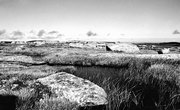Much like an architect planning for a building, authors have blueprints to follow too. While the setting, characters and themes may vary, all short stories follow the same basic structure. Plot structure is evident in almost all short stories, novels, films and other forms of narrative. The typical manner of discussing plot is to think of it like a mountain or a roller coaster.
Consider a roller coaster. It starts out slowly as you get strapped in and wait for it to start moving. Then it moves slowly, climbing towards a peak. The tension builds as you approach the peak and then suddenly the cart takes off on a wild ride filled with twists and turns that eventually slow down as you head back to the platform and the ride comes to an end. The plot structure of a story works in a very similar manner with things starting slowly in the exposition, tension building in the rising action, a sudden burst of excitement during the climax and things settling down during the falling action before coming to an end in the resolution. Successfully identifying these elements helps readers to fully engage with the text.
Exposition
The exposition is like the beginning of a roller coaster. It tends to be the most boring part of a story because it has business to take care of. The author straps you in for the ride by introducing you to the characters, identifying the protagonist and antagonist and establishing the setting. To identify these elements, look for whom the action or narration surrounds and find details in the story that give you a sense of time and place. Keeping track of these key features will help avoid confusion later on.
Rising Action
The rising action of a story is similar to a roller coaster slowly approaching the peak. The tension begins to build as the author sets the stage for what is to come. At this point in a story, the author introduces you to the conflict and moves the plot forward with an inciting incident that gets the conflict going. To find instances of rising action, search for the protagonist coming face-to-face with his problem. As the story continues, the conflict should become more intense. Complications also arise, in the form of events or characters that distract the main character from resolving the conflict.
Climax
The climax usually comes about three-quarters of the way through the text and occurs when the conflict reaches its height. If you were on a roller coaster, this would be the point where you would likely start screaming in response to all the twists and turns. This is the part in a story when the action is at its peak. The protagonist is directly challenged by the antagonist. The story includes a moment of clarity for the central character, after which she faces a dilemma related to the conflict. The choice the protagonist makes will impact later events of the story. Look for the climax at the tale's most dramatic and pivotal point, when the main character has a difficult decision to make.
Falling Action
The falling action occurs as a result of the choice the character makes during the climax. Like in a roller coaster approaching its return to the platform, the falling action of a story slows things down in preparation for the end. Falling action is the shortest part of the plot and appears as events start making their way to a close. During this plot segment, characters may be reunited and realize that the conflict has ended. Look for a decline in action and signs that a conflict is on the brink of being resolved.
Resolution
The resolution marks the end of the story. If you were on a roller coaster, the cart would arrive back at the station and you would be ready to exit the ride. The protagonist should have solved his problem and tied up any loose ends in the story. A good test for the resolution is checking to see whether the conflict has been resolved. Look at the inciting incident and ask yourself, has the initial problem been solved? Has the main conflict been resolved? Look for both internal and external growth in the main characters and think about what lessons they have learned on their journey.
Other Plot Elements
After you read the story, find literary elements that deal with the entire narrative. Morals and themes can be derived by reflecting on what the characters have learned or should have learned from their experiences. Morals should be universally applicable and not story specific. Because you know what happens at the end of the tale, you can also find instances of foreshadowing, which includes dialogue or descriptions that hint at future events. In addition, figuring out who is telling the story will help you comment on the text's point of view, whether it be that of the protagonist, a secondary character or an omniscient narrator.
Related Articles
References
Resources
Writer Bio
Russell Paul teaches English and yearbook at Gaston Early College High School in Dallas, North Carolina. He is a National Board Certified teacher. Paul attended Michigan State University, where he obtained a bachelor's degree in English, and Western Governor's University for a Master of Education in instructional design.











